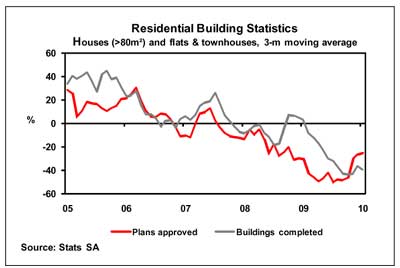SA Residential Building Statistics - Contraction in residential building activity continued unabated in early 2010
Contraction in residential building activity continued unabated in early 2010
Residential building activity in the South African housing market showed a significant contraction in January 2010 compared with a year ago, despite indications that the pace of contraction slowed down towards the end of last year.
The real value of building plans approved for new residential buildings was in January this year 12,1% year-on-year (y/y) lower at R1,03 billion (R1,17 billion in January 2009). The real value in respect of residential buildings constructed was down by a significant 43% y/y in January to a level of R875,9 million, from R1,54 billion in January last year. These real values are calculated at constant 2005 prices.
The number of building plans approved for new housing was down in all three segments (houses, flats and townhouses) compared with a year ago (see table below) to a level of 2 483 units in January 2010 from 5 535 units in the same month last year. This came to a drop of 55,1% y/y, or 3 052 units on a year-on-year basis.
On the construction side, the volume new housing units completed was down across all three segments of housing in January, by 52,6% y/y, or 2 507 units to 2 255 units (see table below).
These developments are an indication that the residential building and construction sector is still experiencing extremely tough conditions. Based on trends during the past year and into the early stages of 2010, positive year-on-year growth in residential building activity will not materialise in the short term.




Courtesy: Jacques du Toit Senior Economist ABSA Bank


Disclaimer:
The information in this publication is derived from sources which are regarded as accurate and reliable, is of a general nature only, does not constitute advice and may not be applicable to all circumstances. Detailed advice should be obtained in individual cases. No responsibility for any error, omission or loss sustained by any person acting or refraining from acting as a result of this publication is accepted by Absa Group Limited and/or the authors of the material.






